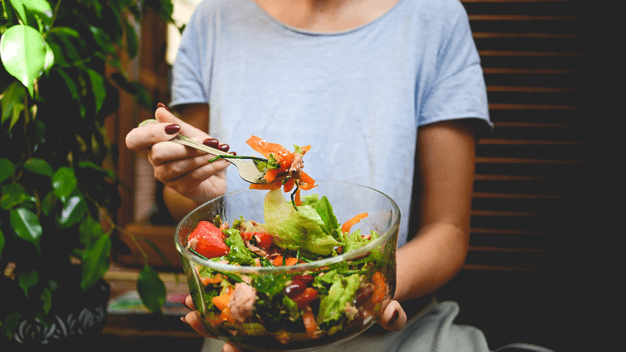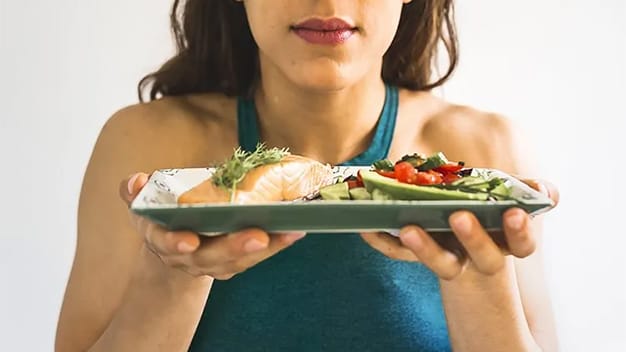Introduction
A common skin condition triggered by exposure to sunlight, particularly ultraviolet rays, is known as Polymorphous light eruption (PMLE). In these diseases, the immune system reacts to UV exposure, which manifests as bumps, itchy rashes, blisters, etc. Recent research in the field of nutrition revealed that oxidative stress that occurs due to UV rays triggers the inflammatory pathway in the skin.
In Ayurveda, PMLE is considered a disease due to an imbalance of Pitta, so it requires a diet that reduces heat from the body by pacifying Pitta, which is cooling and anti-inflammatory, and a diet that acts as an immune modulator. Along with this diet should be antioxidant-rich, hydrating, which improves overall skin health by restoring skin balance and supporting skin healing. In this article, you will find out what to eat, what to avoid, daily meal suggestions, etc.
Foods to Eat in Polymorphous Light Eruption (PMLE)
1. Antioxidant-Rich Diet Plan
The compounds that protect the body from free radical damage and oxidative stress are known as antioxidants. As we know, oxidative stress that occurs due to the UV rays trigger the inflammatory pathway in the skin in PMLE. So, diet plans that focus on antioxidant-rich foods will support PMLE safely and effectively.
- Whole Grains and Legumes: Plant-based proteins, polyphenols that support detoxification, digestion, etc. must be included in the diet like quinoa, lentils, chickpeas, brown rice, barley, etc.
- Vegetables: Vegetables that are full of beta-carotene, lutein, lycopene, and vitamin E like green leafy vegetables i.e. moringa leaves, spinach, etc., carrots, beetroots, sweet potatoes, tomatoes, etc. must be included in the diet.
- Fruits: Fruits that are high in polyphenols, flavonoids, anthocyanins, carotenoids, and vitamin C like pomegranate, citrus fruits like lemon, oranges, grapefruits, Amla, Papaya, etc. should be included in the diet.
- Nuts and Seeds: Omega-3- 3 fatty acid, lignans, selenium, Vitamin E rich nuts and seeds should be included in diet like sunflower seeds, almonds, walnut, chia seeds, flax seed, etc.
- Herbs and spices: Herbs that combat oxidative stress are turmeric, ginger, cloves, cardamom, cinnamon, etc.
- Oils: Olive oil, Ghee, and coconut oil reduce oxidative stress and can be used in PMLE.
Diet Chart Rich in Antioxidants
| Meal | Food Included |
| Breakfast | Ragi porridge with cardamom or oats with walnuts, Amla juice, flax seeds, herbal tea |
| Mid-morning snack | Handful of almonds with raisins or almonds with sunflower seed, fruit juice, or fresh fruit salad |
| Lunch | Moong Dal Khichdi (porridge) with Dal or brown rice with Dal, beetroot salad, mixed vegetable curry |
| Evening snack | Warm golden milk or herbal tea with turmeric, roasted Makhana (fox nut), or roasted chickpeas. |
| Dinner | Steamed vegetables or steamed sweet potato and broccoli, chapati with ghee, warm jeera water, or warm golden milk |
2. Anti-Inflammatory Diet
As we all know, inflammation is the body’s defense mechanism that helps to remove foreign and harmful stimuli and begins the healing process with the help of the immune system. An anti-inflammatory diet strengthens skin, modulates immune response, reduces inflammation in PMLE. Fermented food like probiotic rich buttermilk, curd, kimchi, whole grains, healthy fats through avocado, olive oil, coconut oil, omega- 3 rich fatty acids can be included in the diet.
3. Include Vitamin D in Your Diet
Most people think that Vitamin D plays an important role only for bone metabolism and calcium homeostasis, but Vitamin D is linked with health benefits that extend far beyond its mentioned actions. As Vitamin D is important to modulate immune response, its deficiency may lead to immune system dysregulation and increased inflammation and hypersensitivity when exposed to the sun. Along with this, inadequate vitamin D in the body reduces skin tolerance to exposure to the sun and, upon exposure, leads to inflammatory reactions. So, vitamin D must be included in the diet from a source other than direct exposure to sunlight. Dietary sources of vitamin D that can be included in diet are:-
- Egg Yolks
- Red meat
- Oily fishes like salmon, mackerel, herring, and sardines
- Liver
- Fortified foods like various breakfast portions of cereal, fat spreads, etc.
- Canned Tuna
- Mushrooms treated with UV light
- Soy, oat milk, almond
4. Pitta Pacifying Diet
As per Ayurveda PMLE mainly occurs due to aggravation of Pitta, specifically Bhrajaka Pitta in the body. So, adding a Pitta pacifying diet to the individual suffering from the PMLE will balance the internal heat of the body and reduce inflammation. Pitta pacifying food is as follows:-
- Include sweet and bitter vegetables in the diet like bottle gourd, ash gourd, bitter gourd, and green leafy vegetables except spinach and mustard.
- Include hydrating food in the diet like coconut water, melons like watermelon, muskmelon, cucumber, fresh coconut, etc.
- Legumes like Masoor Dal, chickpeas, Moong Dal, etc. should be included in the diet.
- Rose water, hibiscus tea, and coriander water (Dhanyaka Hima) act as the best pitta-pacifying herbal beverages.
Diet Chart to Balance Pitta Dosha
| Meal | Food Included |
| Breakfast | Ragi porridge with milk rose tea or fennel tea |
| Mid-Morning Snack | Coconut water with mint or coriander water |
| Lunch | Rice with Moong dal, bitter gourd vegetable, or bottle gourd vegetable |
| Evening Snack | Roasted Makhana (fox nut) with hibiscus tea |
| Dinner | Barley porridge (Khichdi) with Ghee, Steamed vegetables, coriander coriander-infused water (Dhanyaka Hima) |
Food to Avoid in Polymorphous Light Eruption (PMLE)
- Spicy and oily foods should be avoided, such as red chilies, deep-fried food, etc., as they stimulate inflammatory responses and increase body heat (Pitta), and PMLE is linked with aggravated Pitta. Along with this, deep-fried food has unhealthy fats that increase inflammation in the body and also increase internal heat. So both should be avoided.
- Pickles and vinegar that are sour (Amla) and aggravate Pitta Dosha should be avoided.
- Intake of excessive curd that is over-fermented (over sour) should be avoided. Mild sour can be included in the diet.
- Heavy food (Guru Bhojana) should be avoided.
- Animal proteins i.e. non-veg food should be avoided especially those that have excessive spice and are fried. As they contribute to increased inflammation and heat in the body.
- Peanuts and products made from them, like peanut butter, etc., should be avoided.
- Mustard-containing food should be avoided.
- Smoking, alcohol, and caffeine should be avoided.

Have A Health Issue?
Consult Online
- Dr. Sahil Gupta (B.A.M.S., M.H.A.)
Ayurvedic Allergy Specialist
CEO & Founder of IAFA®
Conclusion
Internal imbalances play a key role in the development and progression of PMLE. A balanced, personalized diet – integrating both Ayurvedic and modern approaches – can be highly effective in detoxifying the body, reducing internal heat and inflammation, and restoring overall equilibrium. While a tailored diet plan can help prevent PMLE flare-ups, consistent dietary adjustments are essential for effective management and for promoting long-term health and well-being.
At IAFA Ayurveda, Dr. Sahil Gupta, an experienced Ayurvedic specialist, provides personalized dietary guidance as per your body’s constitution and skin needs in PMLE. If you struggle with sun-induced rashes, skin irritation, blisters, or papules, consult Dr. Sahil Gupta at IAFA Ayurveda and get a personalized Ayurvedic diet plan that helps to manage PMLE and supports healthy skin.
Frequently Asked Questions
Question: What is the Effect of My Diet on PMLE?
Answer: Our diet directly affects our body and when we take a personalized diet for PMLE it helps in reducing inflammation, the body’s internal heat by its antioxidant and anti-inflammatory, and hydrating properties. On the other hand, if you take processed, spicy, oil food then it worsens symptoms by increasing internal heat.
Question: Can PMLE be Cured through Diet Alone?
Answer: No, proper diet plays an important role in managing the PMLE but alone the result will not be so miraculous. By conjugating the personalized diet with Ayurvedic treatment one can cure PMLE.
Question: How Long Does it Take to See Improvement in PMLE Through Dietary Changes Along with Ayurvedic Treatment?
Answer: Improvements in the case of PMLE vary person to person depending upon consistency in the diet following and patience that person takes during the treatment. Within 3 to 6 months results in reduced recurrence and improved skin health can be seen.
Question: What to Eat with PMLE Diseases?
Answer: Antioxidant-rich diet, anti-inflammatory diet, cooling foods (coconut water, tomatoes, green tea, walnuts, melons, etc.), and lots of hydration, etc. help to reduce inflammation and protect against sun damage in PMLE.
Question: What Should be Avoided in the Diet for PMLE Diseases?
Answer: Spicy, sour, heavy, deep-fried, processed food, excessive alcohol and caffeine consumption, and Pitta-aggravating food should be avoided in the PMLE diseases.
Question: Can I Drink Hot Beverages or Drinks if I Have PMLE?
Answer: Herbal teas that have cold potency (Sheeta Virya) can be included in the diet. If hot beverages have to be taken, let them cool down first as the high temperature of beverages may lead to skin irritation.
Question: Should I Consult an Ayurvedic Practitioner Regarding My Diet?
Answer: Yes, a personalized diet according to your Prakriti (body constitution) can ensure the best results in treating the PMLE condition.
Was this Page Helpful?
Read More Articles

Polymorphous Light Eruption (PMLE)
Discover the best diet plan for Polymorphous Light Eruption (PMLE) patients. Learn…

SIBO (Small Intestine Bacterial Overgrowth)
Explore the Ultimate SIBO Diet to manage Small Intestinal Bacterial Overgrowth. Find…









